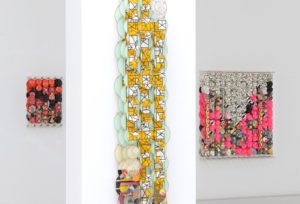At Studio La Città gallery Jacob Hashimoto (born in 1973 in Greeley, Colorado, lives and works in New York) presents a series of unpublished works that reflect on the possible intersections between landscape and abstraction with the exhibition The Heartbeat of Irreducible Curves.
Also in this case the research starts from his now famous kites, made with hundreds of Japanese paper disks set in bamboo frames of different sizes and colors. The complex suspended stratification of these modules creates changing and extremely suggestive visions, based on the joyful coexistence of seemingly irreconcilable opposites, such as density and lightness, incommensurability and order, rule and license, conceptual rigor and sensory solicitation. Each work is conceived as a varied macrocosm in which even the smallest detail seems to be able to enclose potentially expandable worlds but at the same time it is an irreplaceable part of the polyphonic harmony of the whole. The individual components, never perfectly identical to each other, act as molecules that, coming together according to predetermined models, give life to real ecosystems of natural, vegetable or artificial inspiration that synthesize an existential event of infinite duration. To the visual and tactile suggestions we then add the poetic resonance of the titles with which the artist suggests further mental images that gently overlap the perceptions of the viewer in a continuous game of evocation and avoidance.
Jacob Hashimoto, with Studio la Città, will also be present until 28 July in Venice on the occasion of the 58th edition of the Biennale in the group show Recursions & Mutations on the Giudecca Island, while in autumn 2019 he will return to the gallery in Verona to enrich the exhibition with a large and original installation that will complete the project.
On the occasion of the opening, we asked him some questions to find out more about the genesis of his work.
Your works are made up of hundreds of modular elements linked together, each of which is hand painted with geometric decorative patterns or precious calligraphies. Do you do them yourself or do you delegate this production to someone else?
Some I do myself, but most are done by my staff and then I assemble everything. There are seven persons working in the studio. Everybody is very specialized: one of my assistant has been working for 10 years only doing small pieces.
How does the production take place?
There are rules, I work with all my assistants a lot: we talk all together before deciding to change things or colors. They teach each other very specific skills so the language gets more and more complicated. At the end I need to touch everything, if something is not right the work returns to the laboratory and we speak about why it’s not successfull. It’s a long process.
Where do the evocative and misterious titles of your artworks come from?
Those are mine. I think about them at and the end they are conceived as little poems about the idea suggested by the composition. It’s a way to change the way you look at the work. The idea is to create complexity and relationship between different kind of beauty.
Your works are characterized by lush color combinations that live in an aerial and three-dimensional space. Would you define yourself more as a painter or a sculptor?
More as a painter.
Do you think so even when you build huge environmental installations?
Yes, because they are more set design and you see them related as a surface. They change, they disappear and they come back.
How did you came to this process that now is very characteristic of you?
I started because I used to build kites to fly in a park across the street. In my studio I had a lot of them and so I thought how I could have used them. Also my father and my grandfather were doing them, it’s a part of the tradition of my family.
Info:
Jacob Hashimoto. The Heartbeat of Irreducible Curves
May 4 – November 9 2019
Studio La Città
Lungadige Galtarossa 21, Verona




Jacob Hashimoto. The Heartbeat of Irreducible Curves, 2019 Installation view at Studio la Città – Verona
ph: Michele Alberto Sereni
Graduated in art history at DAMS in Bologna, city where she continued to live and work, she specialized in Siena with Enrico Crispolti. Curious and attentive to the becoming of the contemporary, she believes in the power of art to make life more interesting and she loves to explore its latest trends through dialogue with artists, curators and gallery owners. She considers writing a form of reasoning and analysis that reconstructs the connection between the artist’s creative path and the surrounding context.






NO COMMENT